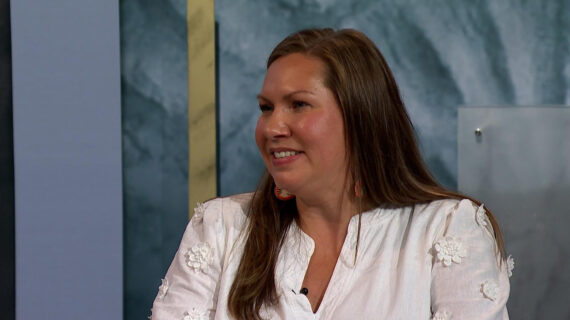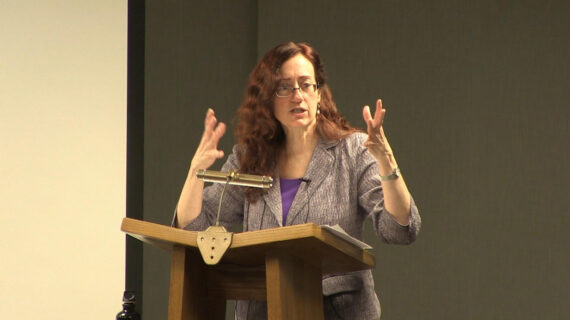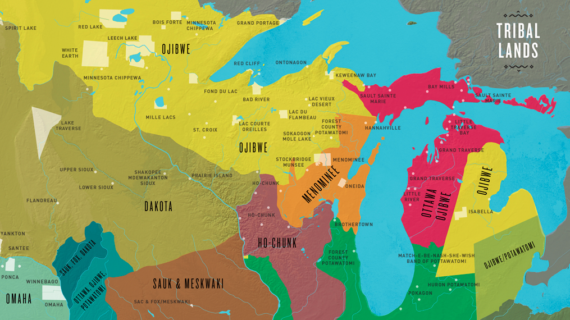– Welcome everyone to Wednesday Nite @ the Lab. I’m Tom Zinnen. I work here at the UW-Madison Biotechnology Center. I also work for the Division of Extension, and in behalf of those folks and our other co-organizers, Wisconsin Public Television, the Wisconsin Alumni Association, and the UW-Madison Science Alliance, thanks again for coming to Wednesday Nite @ the Lab. We do this every Wednesday night, 50 times a year. Tonight it’s my pleasure to introduce to you Greg Nemet. He’s a professor in the La Follette School here at UW-Madison. He was born in Montreal, Quebec. And I think he’s the second speaker in the last few months who was born in Montreal. He went to high school in Boston, Massachusetts, and went to Dartmouth College for his undergraduate degree in geography.
Then he went to UC Berkeley to get his PhD in energy and natural resources?
– Greg: Just resources.
– Energy and resources. Unnatural resources, absolutely. He came to the La Follette School in 2007. He has written a book called How Solar Energy Became Cheap. Tonight he’s gonna be talking to us about that topic and others. It’s pretty amazing to think that the photovoltaic panels up on our roofs are gonna get, and you know, they’re a lot cheaper now than they were 10 years ago, or probably even two years ago. It’s gonna be interesting to see where the trend is going. Please join me in welcoming Greg Nemet to Wednesday Nite @ the Lab. [audience applauding]
– Great, thanks everybody for coming out. So tonight, I’m here to talk about my book. It’s a pleasure for me to actually have something to show, instead of just an idea that I will write a book. But, I have to say, I had never written a book before, and until maybe six months ago, I’d never given a talk about a book before. And it’s hard, because this is like 100,000 words of science in here, and trying to distill that into 30 or 40 minutes is a challenge. So what I’ll do tonight is just try to pick out some of the most important themes. I have to say that I have been asked to give a book talk, and was given five minutes to give it. So this is kind of a luxury. [audience laughing] So if I’m just kind of lounging around up here, that’s ’cause I’m enjoying this pace. So, yeah, so that’s what I’ll talk about tonight. And my perspective on this, this isn’t just about solar.
So my idea is that we can make better choices about novel technologies that we’ll need to deal with climate change, if we can understand some of the previous technologies and how they’ve developed, and especially those that have been successful. And there’s no question that solar photovoltaics have been successful. So that’s the story I wanna talk about tonight. So, and you know, I guess the other thing I’d say is I’d never written a book before. When I was thinking about starting this project about two years ago, I called up a mentor of mine, he was a Austrian guy who’s one of the smartest people I’ve ever met, and I learned so much from him. And I called him up and I said, “Yeah this, probably gonna do this, “interviews everybody around the world “and find out about solar and all this. ” And he’s like, “Gregory, nobody reads books anymore. ” [audience laughing] So I had to overcome that initial counseling and advice that I got from him, and ultimately try to find a reason to actually spend the time on a long form. And really, the motivation that got me through is that I’ve done a lot of work over the last 15 years or so, collecting data on solar and doing statistical analyses, and doing modeling, and econometrics, trying to understand what the drivers were of the cost reductions and how fast things have been coming down. But in all that work, I really got the sense that there were important factors, or in statistics we might call them variables, that were just hard to operationalize.
There were things that were hard to measure, hard to count, hard to put in a model. And so what I wanted to do was to see if that was really true, and do a much more descriptive, long-form, thicker approach by going to talk to people, and spending an hour, hour and a half with people, and try to get, out of their heads, what they thought the most important factors were. And there were certainly things that have come up that I’ve never been able to put into models, and I’ve never seen in anybody else’s models. And I think the one that’s kinda most frequent, and I think most important, is this idea of international flows of knowledge. So it’s machines moving from one country to another, but it’s also people moving from one country to another, there’s tacit knowledge, so knowledge that’s not in reports, or in scientific journals, but it’s in people’s heads, it’s know-how. And those people were extremely mobile, moving from Australia to the U. S. , then from U. S. to Germany.
Germans going to China, Chinese going to Australia to get trained, going back to China and starting companies. That flow of people and ideas around the world made all of this happen. And I really think that if the efforts were limited to individual countries, one, we may not have seen the success of solar, and if it happened, it would’ve happened a lot more slowly. So that, I think is one of the outcomes of having done this thicker approach. So today, I’d like to kinda describe one, how solar got cheap, two, how it can be a model, so something that other technologies can emulate, and then three, why that model’s insufficient, because whatever else we need to do, it’s gonna have to go a lot faster than solar. So solar was successful, but it was way too slow. So we need to find ways to speed it up. So those are the three things I want to do. How solar got cheap, how it can be a model, and why and how it can go faster. But first, I’d like to just provide a little bit of context to kinda show you where I’m coming from.
I’m in the School of Public Affairs and work on energy policy. But before even I do the context, I want to do the most important thing was, what made this project really fun was having this great research team. And these were six students that just did so much effort on this. Travis Shoemaker has done more work on the story of Japanese solar in English language than exists already. Atiya did interviews in South Africa and Pakistan, and did a lot of work on the connections between German machine makers and the setting up of factories in China. Rohan Rao did a lot of work on the trends in technology. Jiaqi’s done a lot of the statistical analysis, and was really helpful in helping me move around China. Andy Lick and I just to have a little hands-on work, Andy used to do solar installing in a previous job, and so I learned a lot talking to him about what actually makes a solar installation reliable, make it work, have the panels not degrade, what makes it expensive. And then Mikhaila Calice worked on the last six months of the project. Was really helpful pulling the text together and editing it, and making it flow well.
So, these guys were great, and it was really fun working with them. All of them have taken a class with me. And then this is kind of the biggest takeaway, or the biggest, or the introductory idea I present in the class. And that’s what we call the iron law of energy policy. So social sciences don’t have things like gravity, or the first and second laws of thermodynamics. So when there’s something that seems like it’s kinda true a lot, we call it an iron law. So that’s a social scientist way of talking about things. So with energy policy, I think there’s one. And that’s that there’s not just one goal that we have when we’re talking about policymaking. And that’s what makes energy policymaking hard, and it often leads to contentious debates.
So we want energy that’s cheap, so we want energy that’s affordable, we don’t want to have recessions and macro-economic shocks that come from changes in the price of energy, and then there’s about a third of the world’s population that uses very traditional energy that’s extremely polluting, and really hard to turn into productive use and development. And so, having access to them for energy is part of cheap. We also want energy that’s clean. So we don’t want kids going to the hospital because of respiratory problems and asthma attacks from air pollution. And we also don’t want damages from an unstable climate that comes from producing greenhouse gases into the atmosphere. And we also want energy that’s reliable. So it’s not just that we want it cheap, we want it on a continuous flow, and that’s coming from domestic sources, or at least friendly sources. Not just for the cost, but because it may affect our negotiating positions on other issues. And I think anyone would agree that in the future, we want an energy system that’s cheap, where the energy is cheap, clean, and reliable. Where we disagree is, in the meantime, which one is most important? Do we really want to target have energy as cheap as possible? Do we want it to be as clean as possible, or is all that really matters a reliable access to energy resources? And that’s where a lot of the contentious debates come in.
From my perspective, looking forward and thinking about an energy transition, I get excited about the idea of innovations. So new technologies, new ways of using energy, new social behaviors related to energy that allow us to have all of these objectives, and have not so much have them be trade-offs, or conflict, or contentious debates, but, ways that we can achieve all of those three goals. ‘Cause that’s really what we want. So that’s why we really target how do we get innovation. And to do that, we need some kind of transition to an energy system. So, that’s kind of my dream and vision and what I get excited about. But there’s also a sobering reality too, which is that in the energy system, things happen slowly. So that’s where, this is kind of the truth that’s really hard to get around if you’re gonna look at historical comparison. These are the primary energy carriers for the whole world for the last 150 years. And for the first third of that time, the primary energy carrier was biomass, traditional biomass.
Mostly wood, cutting down trees and burning them. And then over time, as we developed things like the steam engine and we’re able to access more and more coal, we could use that, and eventually start using that for transportation. Coal became the primary energy carrier. But that took six or seven decades to go from a wood-based energy economy to a coal-based energy economy, and then to get to one where the primary energy carrier is oil took another half century or more, and then now we’ve got a mix of sources that we’re talking about. But if we’re talking about trying to transition to a low carbon future, where the primary energy carriers do not involve the combustion of fossil fuels and putting the CO2 into the atmosphere, we hopefully can do something a lot faster than the transitions in the past. ‘Cause those have happened over a decadal scale and we don’t have that much time if we’re thinking about things like, air pollution, but also especially climate change. So that’s a sobering reality. The other sobering reality is that, if you put CO2 up in the atmosphere, this is really different than putting particulates or sulfur dioxide up into the atmosphere, those are really damaging and hurt people. But, those get rained out of the atmosphere in days and weeks. When you put CO2 into the atmosphere, it stays up there for something like 100 years.
So, that’s another sense of inertia. So for me, if you have this slowly changing energy system and this inertia in the climate system, that to me doesn’t convey that all of this is just gonna take time, it conveys we need to do a lot quickly, and there’s urgency to it because the feedbacks are going to be slow. So, that’s kinda the challenge here. So, that’s something I’ve been talking about in my classes quite a bit, is these kinda fundamental, slow, inertial forces in the energy and in the climate system. What I find is that it tends to depress people. It tends to make people think that this is all kinda hopeless and everything’s gonna happen slowly. So, what I’ve done over time is to start to think, “Why do I actually work on this, “if all of this seems so, kinda, languid?” And I’ve put together this list of reasons to be optimistic about dealing with climate change. And this is something I now end my courses with and probably pretty soon, I’ll start my courses with. But, I think each of these, I could do a week on each of these eight points and that actually might be a pretty neat course on its own. But tonight, I wanna talk about the one that I think is a driver of some of the others and is probably the most exciting, has become the most compelling.
And that’s that technology for dealing with climate change has gotten a lot better. And I’m just gonna talk about one of them today with solar. So, here’s the first thing to think of, is that solar panels are now extremely cheap. So, here’s my picture of the last 20, 30 years here. These units here are in dollars per megawatt hour. So, one megawatt hour is how much electricity an average residential home in the U. S. uses in a month. So, you can think of a megawatt hour as your monthly electricity bill. And that’s what that dashed line is there.
So, about $120 a month, and that stayed pretty stable over the last 30 years. If you look at solar, that cost has come down. It would have been $1,000 a month for your electricity bill if you did solar panels in 1990. But, now we’re down to something like 300 by say 2005. Then, this is where experts thought we would be by 2030. So, something in the range of around that grid electricity. These are, we did these structured elicitations of experts, where they thought things would be in 2030. Here’s another data set here, this is, let me put one more here. These are a million homes in the U. S.
that have put solar on, and we’ve estimated the cost of electricity from those homes. So, you can see that a lot of them are well above grid electricity. But some of them are below the cost of grid electricity. And this is without subsidies. This is just the real cost of installing a solar panel. So solar has come down quite a bit. Here’s the average of all those blue dots, those million homes. And then these are utility scales. This is really large-scale solar that’s being done in bigger places. And there’s actually two plants like this, going on in our state in the next year or so, those’ll be built, and so these prices are way below the residential solar prices.
And so now, and then those last circles there are some of the large solar plants in places like Mexico, Chile, Saudi Arabia, and I think there’s one other. But, they’re all sunny places, so that helps a lot. But, those are really cheap, that’s really cheap electricity. Those lowest dots there, that’s $20 a month for your electricity bill, if you could do that. That’s probably the cheapest way that humans have ever been able to produce electricity on a large scale. So, that’s something, if we blow it up here you can see that those prices, that $20 per megawatt hour from last year, those are below the most optimistic prediction by the most optimistic solar expert that we interviewed in 2010. So there’s about 200 elicitations right there, and the reality now is beyond where scientists thought it would be, 10 or 12 years from now. So, that’s to say solar is now cheap. The other thing, and this is the part that I’m focused on, not just how cheap solar is, but how much it’s improved. And it’s fallen in cost more than any other energy technology.
So that’s my motivation to say, how did this happen? The other thing is that solar’s not the only technology that’s done this. So, solar’s done this, but wind has a similar curve. Not quite as cheap. And then batteries seem like they’re well on their way to following the solar model. And some of those, that battery curve probably needs to be updated, ’cause the last couple of years have led to some even cheaper. So now that if we think about having solar, but then you can store the energy for say four to eight hours, and maybe in the future for longer than that, that really starts to allow you to depend more and more on solar. But the point that I’m really trying to look at is the slope of these lines. How fast and how much these technologies have fallen in price. And solar’s really the star on that. Okay, so that’s what this project is about, three questions.
How did this happen? Second, why did it happen so slowly? Why did it take so long? And then what can we learn from it? And how can it be a model for other technologies? So, if we had a tornado drill right now, or in say in two minutes, and we all had to go somewhere safer than here, I would be okay if you just got this slide here. So, this is the full story, and I had some great graphical design help from the Wisconsin Energy Institute to take this 100,000 words here and distill it into one picture, here. So, your vertical axis there is that same metric we’ve been looking at, so think about it as dollars per month for your residential electricity, and it’s a log scale, so those are factors of ten at each of those [clears throat] indicators of cost right there. And then we’re looking at from 1950 ’til present. And then I put Albert Einstein there, ’cause that’s really where the initial science came from for activation energy and band gaps, and the idea that photons would interact with molecular structure and create a free electron that you could use for electricity. So, that’s Einstein, way back. That’s what he actually won the Nobel Prize for. I don’t know if people know that, the photoelectric effect. So, here are the breakthroughs and the steps along the way. So, Bell Labs, this laboratory for the phone company in New Jersey, was really focused on being able to develop transistors, and in the course of that, they were working with silicon quite a bit, and they realized that they could produce an electric current.
And they really did use the Einstein science to understand how they could actually make this work. Not just as a example that it works, but actually as a real efficient cell, and they got about a 5% efficient cell in 1954. Then, there’s a pretty quite period for a while until Project Independence. So, that’s the Arab oil embargo in October 1973. The U. S. gets really serious about energy, and some support for alternative energy and some support for solar. And so even though that was a tiny part of the overall effort to become oil independent, about $2 billion of research money went into solar from 1975 to 1985, and that really was, pushed U. S. into leadership in the whole world in developing solar.
The Japanese had the same response. The Japanese are even more vulnerable to the oil price shocks in the 1970s than the U. S. was. They had almost no domestic production. And so they did a similar type of R&D effort on developing technology as well. In early 1980s, California had this way of compensating wind farm developers for developing alternative energy and wind electricity. And they set up these standard contracts. And it’s interim standard offer contract number four that’s the hero here. And it guaranteed a price, that was about twice as much as the wholesale price of electricity.
So, if you would build a wind power plant, you would automatically get this price for ten years. And about $2 billion of Wall Street money went into developing and purchasing wind turbines in California in the 1980s as a result of that contract. And that’s really what the Germans picked up on later on with that EEG in 2000 and 2004. They had been sniffing around and gone to California and learned about those contracts. There were some municipalities in Germany that had experimented with this on a really small scale, and at the federal level, they launched the program in 2000. The Japanese started that Rooftop Program in 1995, that was the first subsidy program. And that was the first demonstration that people would actually choose and pay to put solar on their own homes. They would get help from the government, like a 50% rebate, but that rebate went down over time and was on a predictable schedule, and after ten years there was no more subsidy. But about 200,000 Japanese homes put solar on their roofs in the late ’90s and early 2000s. Around that time, in 2001, this entrepreneur from China, who had spent 16 years in Australia, and was working in Australia in 1994, he and his thesis advisor went to China to set up a manufacturing facility in China, and they came away completely discouraged.
And they said that it was missing any appropriate infrastructure, and there’s no possible way that they could set up production in China. And so they went back to Australia and started their company in Australia. Five years later, the guy who was a student and had been the translator on that China trip, went back and tried to do it on his own, and he started his own company. He scrambled together about $5 million and started a company called Suntech in 2001. And by 2004 or 2005, it went public on the New York Stock Exchange and that guy, Zhengrong Shi, who was the translator on the trip in 1994, was the wealthiest person in China for three years as a result of building up this company, Suntech. And about $500 million of U. S. pension fund money that had gone into that IPO in New York, went to China to set up this Suntech company, and that became the biggest solar company in the world. After a while, the global financial crisis happened, a lot of countries ended their subsidy programs and the market went away. So, China decided it was time to make its own market, and so it created its own FIT, which is a feed-in tariff.
Again, using the idea that the Germans had perfected in the 2000s that they had borrowed from California from the 1980s, this idea of giving a guaranteed price for electricity for 10 or 20 years against all solar. And then by the end of this period, from 2011 onward, China’s not only the biggest producer of solar panels, it’s the biggest consumer of solar panels, and it still is today. And now we have something like $20 per megawatt hour electricity from solar. So, that’s the story. Maybe I’ll just put in a few highlights to go through the story, but that’s pretty much this evolution. There’s no gigantic breakthrough, that’s one lesson here. It’s also not something that’s just happened in the last ten years. It’s 60 years of incremental improvement, of research and development in certain areas, developing niche markets in certain areas, creating markets in other areas, and then this flow of knowledge coming around the world that really makes this all happen. But, that’s the real story, but let me, yeah, I’ll just put a couple of other things here. Here’s just looking at the importing and exporting countries.
This shows China went from being a big exporter in the middle of the part, by the end they’re kind of importing and exporting. They’re producing about as much as they use. But, this is just an example of the type of work that the students and I did. So, this was this really important patent from 1954, and we went back and looked at all the prior art that that patent cited, and there were eight patents. But you can see they’re really pulling together a lot of different types of knowledge. So there’s this, the material, the high purity silicon, that’s part of it. A light-sensitive device, that’s another part of it. And then thinking about the current and how the electricity moves around the PN junction, is kinda the core of the solar material there. And then we even went back to one step, one generation behind that, of what the prior art for those patents was as well. So, you can really see where some of this is coming from.
But, it’s also really clear that Einstein played a role in Bell Labs being able to do this. So, he really, it was extremely theoretical of course with Einstein, but it clarified what needed to be done, and it took three or four decades to actually get from Einstein’s idea that light could actually produce electricity, to being able to harness that in kind of an efficient form. And in the top right, that’s that first cell. So, lots of enthusiasm in the 1950s when they did this. It was on the front page of The New York Times, that solar was gonna be the technology of the future, and it could be limitless energy available now from 1954. Here’s another one I’ll just put up. This is probably my favorite slide, and it’s a little bit much to it, but, this is a learning curve. And this has been so fundamental to how the technology’s progressed. But, it’s also been fundamental to the policy mechanisms that have been put in place. So, on the vertical is a measure of cost.
And then on the horizontal, it’s not time, it’s how much you’ve produced, how many units you’ve produced. And so the idea is that as you build more units, the costs come down. And this really came from this guy Paul Maycock, who worked at Texas Instruments in the 1960s, and they were doing calculators and this other kind of, almost like an early microprocessor technology, and they realized that as their production increased, and their scale increased, they could get the costs to come down substantially. So, he introduced this idea at the solar energy program in 1975. And what I think is really cool, very empirical, he goes back to the last 16 years, takes the data on cost and production and then says, “Well, with calculators, we get a learning rate “of about 20%. ” That means that if you double production, you get about 20% drop in cost. And he said, “Let’s just push that out “into the future, without much limit “on how big this could get. ” And so, he pushed it out in the log scale on the right there, and I plotted out where we were in 2018, in terms of cost and production, and he was pretty much right on; in fact, things have gone a little bit faster than he expected. So this idea of a learning curve characterizing innovation and technological change and improvement, seems to have been pretty consistent and seems to have worked pretty well. The other thing that he introduced was this idea that you might need policy here.
So, you might need some, that’d be called a buydown. So, you might have to invest in lots of expensive early units, to get the volume to get the cost down. And so he put a number on that, he put a number of 10 to $20 billion, and that’s a 1975 dollar, so I use about a factor of four, and so to increase, that’s something like 60 to $80 billion in today’s dollars. The German subsidy program, which I mentioned from 2004 to 2012, was instrumental in creating scale for the industry and getting the cost down. That program cost about $220 billion. So, Maycock was pretty close on that, and I actually think he might have even be closer than that, it seems like the Germans probably paid too much in terms of subsidizing. They could have subsidized and gotten the same outcomes for about half of what they did. But, they didn’t know, or maybe they hadn’t seen this slide from a few years earlier. [audience laughing] Pretty prescient and interesting to see. Niche markets were important, not just producing electricity but calculators and watches and satellites.
Those were crucial, and the Japanese really took advantage of that and this is Japanese, the solar program I talked about here. This is the German program, where they had this feed-in tariff, where they were offering about 54 cents per kilowatt hour for electricity. So, in Madison, we pay about, anyone know a number we pay for electricity roughly?
– Woman: 15.
– 15 with everything in, yeah, maybe like the unit price is more like 10 or 12 cents. So, they were offering, and their electricity’s maybe twice as expensive as ours, but they were offering twice as much as even that. So it was a really generous subsidy, and lots of people took advantage of it. And electricity rate payers in Germany paid for about $200 billion of the subsidies that went to people installing solar. So later, it was kind of under attack a lot, because people were paying about $20 a month on their electric bills more, because of this. The manufacturing seemed like it had moved out of Germany, into China. And so there’s this question about why are we spending $200 billion? What are we getting out of it? And one NGO portrayed it kinda nicely, in a way, that this was Germany’s gift to the world.
It was a $220 billion gift to the world. But, really what it was, was this gift of scale. And this moving along the learning curve to the right to get the cost down, so that now we can be talking about $20 per megawatt hour. And that was really a crucial step in that. Oh, yeah, and this is another way to think about the gift, I just put this on recently, forgot it was on here. There was an estimate, and this is in a business, this is in Bloomberg News, that because renewables are so inexpensive now, if we think about the long-term cost, like over the next 50 or 100 years, of dealing with climate change, it’s about something like $10 trillion less now because we’ve got cheap wind solar and batteries. So, if you think of $200 billion as playing a role into saving $10 trillion, that’s the real gift to the world it’s that $10 trillion of savings. Yeah, see, these are some of the ways that solar got cheap. So, plant size, economies of scale got much bigger. The efficiency of the panels about doubled over this time.
So, how much electricity you get from the sunlight you put on it. The price of the input material, silicon, went way down, and that was also because of scale. How big the wafers were. So, I should have brought a wafer, I have some in my office, but you can make bigger and bigger wafers and that had some scale economies. Wider wafers, but thinner wafers, so you could get many more solar panels out of the same amount of expensive silicon material. So, thinner wafers were a really big part of it. And then getting the numbers that would break or not be usable at the end of the process, getting that down, so that you had close to 98% or so of the panels being usable at the end. So these are all kinda technical improvements that led to some of these cost reductions as well. Okay, here’s the price is going down. I guess, one thing about China, I guess I don’t have too much time to get into it, but it was an extremely competitive, it is an extremely competitive market.
And the industry concentration, I think I’ve got a picture of that here. This is, on the top left, there, this is a share of global production by the largest firm. For a long time, there were these large conglomerates that dominated solar manufacturing, and there’s only maybe three or four of them. But, when China took off, there’s many of them. Every province wants to subsidize its own producer of solar, and so you’ve got many producers there. And so they’re very competitive with each other, and so we’ve got, none of them are more than 10% market share of the whole world, and so the margins come way down and the prices come way down. And so that’s a big reason why the price of solar has come down as well. It’s this competition within China. So, now that we’re down to 20 or even $18 per megawatt hour, that’s really China’s gift to the world, was doing some of those accomplishments we talked about before. Okay, let’s see, you can kinda see it moving around a little bit.
So, this is a– It’s actually not supposed to really be, well. This is a manufacturing facility in China. And one thing that’s striking about it, is how many people you see in this picture. [audience laughing] There’s a few reflections of people coming to be in awe of these machines that are working here, but that’s how solar works in China now. That wasn’t true 15 years ago. So, there, China’s low-cost labor advantage was really helpful, and that really got things started. But, at some point, as the scale increased, it became reasonable and feasible, for especially German and Swiss companies, to make these machines and not just borrow secondhand equipment from the semi-conductor and the computer industry, and try to repurpose them, but actually make machines made to make solar, and then have these experts bring these machines from Switzerland to China, and then they’d stay there for six months and set them up, and optimize them and make them work together. And that was know-how that had been trained other places, had experience working in Germany and Switzerland, and then now is being deployed in China. And so now we’re talking about the Chinese trying to make some of these machines themselves, but also the new emerging markets. Markets that are now doing a billion watts of solar a year installations.
Turkey, Egypt, India, Saudi Arabia, they’re all talking about saying, “We can buy these machines too. “We can hire some people, some consultants to come “and set them up for six months, “and maybe we even save on the cost “of moving these things around. ” It’s not a labor cost advantage anymore. And so I think that, really is, China’s gift to the world, is that we can have this production happening in lots of places now, for low-cost solar. And then, okay, maybe just to kind of wrap up the story here. What I wanted to do is have it be somewhat generalizable. And to sort of characterize it in kind of a more concise way. So that’s what I just talked about to you was really this anecdotal thick way, and the book is full of stories that I heard and thought were interesting. And also stories that I heard and thought were interesting but I couldn’t put in the book, but I’ll talk about ’em in my class. But, some of these, it’s basically three stages if we’re talking about developing this technology.
There’s creating the ideas, creating the, doing the engineering, creating the technology. That’s Einstein, that’s the Bell Labs guys, that’s what the U. S. was doing in the ’70s. Then there’s building a market, so creating demand for the technology, that’s what really started a little bit on a nascent scale in the U. S. when the government was buying solar panels, they did five rounds of buys of solar panels, it really got the industry going in the late ’70s, and early 1980s. But, then it was the Japanese with the Rooftop Program, the Germans with their feed-in tariff, and eventually the Chinese with their feed-in tariff, and then finally this kind of learning curve of getting the cost down, of making it cheap, of an achieving scale. So, thinking about each of those stages on the creating the technology, there’s the Einstein stuff, there’s doing R&D, but it’s not just one-shot R&D, let’s develop a solar cell and then someone will commercialize it. It’s continuing to do R&D for 30 or 40 years later, where the R&D shifts to what new materials? What are the bottlenecks? Should we start doing R&D on manufacturing? Should we start doing R&D on developing the machines that would lead to some of these? Or looking at the supply chains of where the materials are coming from? So that was important for R&D too.
And then this crucial aspect of knowledge spillover. So, knowledge moving from one person to another, from one company to another, and definitely from one country to another. That was really characteristic of the solar story. In terms of the market stuff here. What was early on, I think, was really important, was it wasn’t a policy-developed market. It was a niche market. So, niche markets, it’s like a technical term for markets where there’s a higher willingness to pay than kind of the overall bulk market. So, we pay ten cents per a kilowatt hour for electricity, maybe people would be willing to pay twice that for green electricity, but, no one’s willing to pay ten times that for electricity, and that’s what solar cost 30 years ago. But, there were places where people were willing to pay that much for solar electricity. And it was the space program in the U.
S. in the ’50s and ’60s and ’70s where the value of having solar there was really high, because it was hard to find other ways to have electricity out in space. A second part under building a market was this really big advantage of modular scale so that you didn’t have to just build one gigantic solar plant and see if it worked. And if it didn’t work, that’s a problem. You could build tiny ones and then scale it up. And so there’s, there are, nine orders of magnitude from the smallest solar cell, which would be one that you’d see in like a watch or a calculator, to the ones that we’re building in deserts, or even actually an hour west of here. That’s about a factor of about a billion in size, and everything in between has been tried. That just allows a lot more markets to be met. And then the policy support, it’s not all defined by one market, because this ecosystem of solar is so global. When the German market got into trouble in say 2012, and people started saying “Maybe this is way too expensive,” there was another market that came up.
So, Spain became a big market, then Italy became a big market, then the financial crisis came up and all of those went away. China created its own market. And so for producers, they didn’t have to be completely dependent on one set of policy makers, or even on an election in order to maintain their markets. And in terms of making it cheap, it’s kind of this old idea of learning by doing. So, produce more to get the cost down. This second one, of iterative upscaling, so, being able to make plants bigger and bigger but learning from the previous plant, that’s what I, I spent about an hour with that guy, Zhengrong Shi, the guy who started the Chinese solar company. It was interesting to see how they started a line, and then after a few months they started a new line. He was scouring the world for used equipment. It was all on a shoe string, but it was about doing the next thing and make it slightly bigger and then getting to scale. It wasn’t just going big right away.
And then the last one there, and this is where I’ll stop. One of the big advantages of solar, it’s the big challenge of solar now, is how do you store the electricity? How do you have the grid manage the intermittency that comes when there’s a thunderstorm or clouds that come on top of a solar ray and all the sudden that electricity’s not available. So those are real issues now that we’re talking about the U. S. using about between 1 and 2% of its electricity from solar. But other countries like Germany and Japan doing more like 5 or 8% of their electricity from solar. But we haven’t had to deal with those problems until we’ve gotten to this stage. And this idea of system integration and only doing it 30 or 40 years later, that’s a big advantage, compared to having to do it right away. And there’s other technologies, like large-scale technologies, we can talk about those maybe later, where you have to do all of that right away. You have to do all the system integration at the very beginning.
And that’s why a lot of technologies had a hard time taking off, because they have to confront so many challenges right away. The market challenges, the technical challenges, and the system integration challenges. So, that’s the story, I think I will stop there, so we have time for questions. But, yeah, appreciate you coming out and happy to talk about questions now. [audience applauding]
Search University Place Episodes
Related Stories from PBS Wisconsin's Blog

Donate to sign up. Activate and sign in to Passport. It's that easy to help PBS Wisconsin serve your community through media that educates, inspires, and entertains.
Make your membership gift today
Only for new users: Activate Passport using your code or email address
Already a member?
Look up my account
Need some help? Go to FAQ or visit PBS Passport Help
Need help accessing PBS Wisconsin anywhere?

Online Access | Platform & Device Access | Cable or Satellite Access | Over-The-Air Access
Visit Access Guide
Need help accessing PBS Wisconsin anywhere?

Visit Our
Live TV Access Guide
Online AccessPlatform & Device Access
Cable or Satellite Access
Over-The-Air Access
Visit Access Guide
 Passport
Passport


















Follow Us